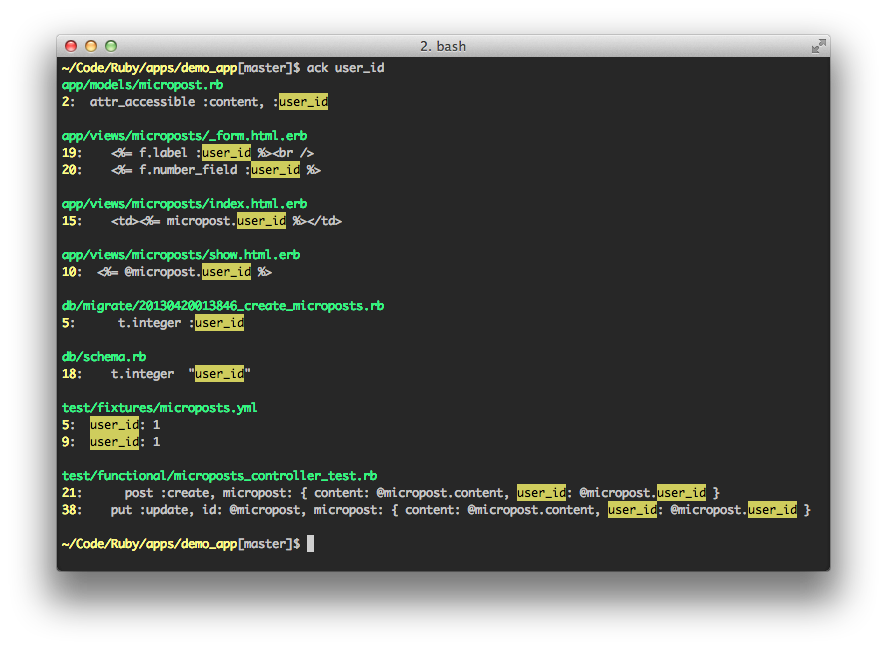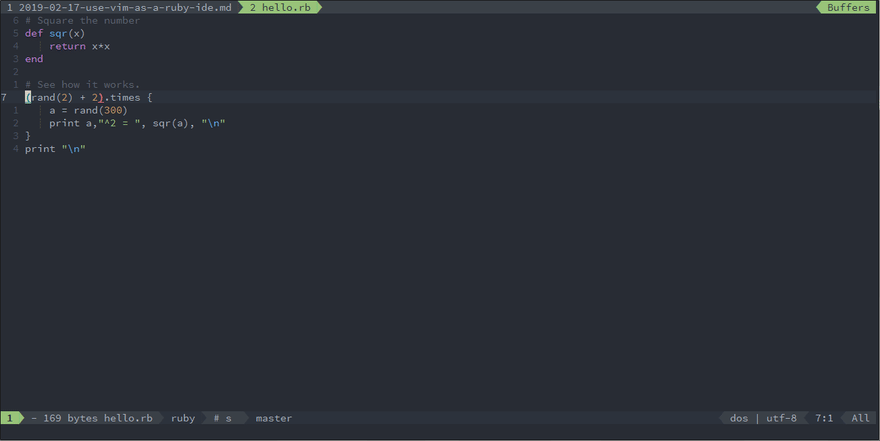
balloon_eval +fork() +netbeans_intg +termresponse

autoservername -footer -mzscheme +terminfo +autochdir +folding +multi_lang +terminal +autocmd +float +multi_byte +termguicolors +acl +file_in_path +mouse_urxvt -tag_any_white As you can see, in this case, the version of Vim I am using is 8.2, and the feature is enabled: VIM - Vi IMproved 8.2 (2019 Dec 12, compiled 00:00:00) What we want to check, in this case, is the status of the “packages” flag. In the output of the command we can easily spot the available features, since they are preceded by a “+” (the missing ones are preceded by a “-“, instead).
#Vim ruby runner software#
Some of them, like the former, are very simple: what they do is basically to allow us hosting each plugin in its dedicated directory, which is added to the Vim runtime path others, like the latter, are more complex, and are able to manage plugins similarly to how package managers handle software packages on Linux distributions. To better organize and integrate them into the editor, several “plugin managers” were created, such as Pathogen or Vim-plugged.
#Vim ruby runner code#
Several plugins are available for Vim most of the time their source code is hosted on Github, and their development is managed via the Git version control system. There is a lot Vim can do out of the box (we covered the editor basics in this tutorial), but its functionalities can be extended further via plugins. Vim needs no introductions: it is based on the classical Vi editor (Vim literally stands for V-IMproved), and is one of the most iconic text editors in the Unix world. $ – requires given linux-commands to be executed as a regular non-privileged user # – requires given linux-commands to be executed with root privileges either directly as a root user or by use of sudo command Requirements, Conventions or Software Version Used
#Vim ruby runner how to#
How to manage vim plugins natively Software requirements and conventions used Software Requirements and Linux Command Line Conventions Category In this tutorial we are going to see how to manage Vim plugins natively using Packages. To manage such plugins, several third-party plugin managers were developed in time, such as Pathogen or Vim-Plug, but since version 8 of the editor, a native way to manage plugins was introduced. A lot of plugins are available for the editor almost always their source code is hosted on Github or similar platforms based on Git. Although its learning curve can be pretty steep when accustomed to more traditional text editors, its usage can dramatically improve productivity. You need to customize g:rubytest_cmd_spec to work with rspec 1.*įix testunit result display in quickfix Added describe|context patterns so we can run examples under a grouping of describe or context.Vim is definitely one of the most venerated text editors in the Unix world. * Remember last run: l to run last run test * Global substitution for %c and %p in customized command (Ivan Tkalin) * Run minitest in RSpec-like DSL (alexbel) * Add Scenario Outline keyword to test cases (Ben Simpson) * support for capybara steak-like dsl (feature/scenario) * rubytest.vim works perfectly with vim-localvimrc, which enables you to set different test run command for different projects. Map / RubyTestRunLast " change from l to / (%p will be replaced by the path of test file, %c will be replaced by the name of test case under cursor) Let g:rubytest_cmd_story = "cucumber %p -n '%c'"

Let g:rubytest_cmd_feature = "cucumber %p" Let g:rubytest_cmd_example = "spec -f specdoc %p -e '%c'" Let g:rubytest_cmd_spec = "spec -f specdoc %p" Let g:rubytest_cmd_testcase = "ruby %p -n '/%c/'" You can customize the command which will be used to run the test case by settting these options in your vimrc file: With this set, test errors will be displayed in quickfix window, and you can jump to the error location quickly by select the error message and hit return (or 'Ctrl-w return' to open it in new window). You can change this behavior by putting this line in your vimrc file: Unzip downloaded file and copy rubytest.vim to your ~/.vim/plugin directory.Īfter installation, press t will run the test under your cursor if you are editing a ruby test file.īe default, the plugin will print output in terminal.


Rubytest.vim will help you to run ruby test (including vanilla test, rspec, shoulda etc.) in vim.


 0 kommentar(er)
0 kommentar(er)
